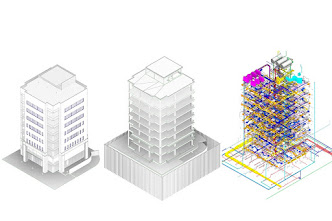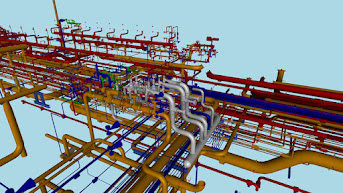Sustainable Design Solutions for Pre-Engineered Building Services - SILICON VALLEY INFOMEDIA PVT. LTD.
The pre-engineered building design has been a growing trend in recent years, with the rise of sustainable construction and modern building techniques. As a PEB designer, it's important to stay up to date with the latest sustainable design solutions to ensure that pre-engineered buildings are not only efficient but also environmentally friendly.
Silicon Valley focuses on pre-engineered building design utilizing advanced tools and software. Our team of skilled architects and drafters collaborate closely with you to incorporate required adjustments and rectifications, providing tailored, high-quality components that meet your specific needs.
Pre-Engineered Buildings (PEBs) are factory-built steel structures that are designed and manufactured according to specific building codes and standards. They are constructed using high-strength steel components that are prefabricated in a factory, shipped to the construction site, and assembled on-site.
PEBs have many advantages over traditional construction methods, including cost savings, speed of construction, and flexibility in design. However, several sustainability concerns need to be addressed in the design and construction of pre-engineered buildings.
One of the primary sustainability concerns with PEBs is the use of energy-intensive materials such as steel and concrete. These materials have a high carbon footprint, and their production and transportation contribute significantly to greenhouse gas emissions.
To address this concern, Pre-Engineered Buildings designers are incorporating sustainable design solutions into their projects, such as the use of recycled steel and concrete, and the integration of renewable energy sources such as solar panels.
Recycled steel is an excellent alternative to virgin steel, as it requires less energy to produce and reduces the carbon footprint of the building. Additionally, the use of recycled concrete can also help reduce the environmental impact of PEBs, as it diverts waste from landfills and reduces the need for virgin materials.
Another sustainable design solution for Pre-Engineered Buildings is the integration of renewable energy sources. Solar panels can be installed on the roof or walls of PEBs to provide clean, renewable energy to the building. This not only reduces the carbon footprint of the building but also saves money on energy costs.
In addition to the use of sustainable materials and renewable energy sources, PEB designers can also incorporate other sustainable design solutions into their projects, such as the use of natural light and ventilation.
The use of natural light can reduce the need for artificial lighting, which in turn reduces energy consumption and saves money on energy costs. Pre-Engineered Buildings designers can incorporate skylights or large windows into the building design to maximize the use of natural light.
Similarly, the use of natural ventilation can reduce the need for mechanical ventilation, which saves energy and reduces the building's carbon footprint. Pre-Engineered Buildings designers can incorporate ventilation systems that allow for the free flow of air through the building, which can help regulate indoor temperatures and improve indoor air quality.
Another sustainable design solution for Pre-Engineered Buildings is the use of green roofs. Green roofs are vegetated roofs that provide a range of environmental benefits, including reducing the urban heat island effect, improving air quality, and providing habitats for wildlife.
Green roofs can also help reduce the energy consumption of buildings by providing insulation, which can reduce the need for heating and cooling. PEB designers can incorporate green roofs into their projects by adding a layer of soil and vegetation on top of the roof, which can be supported by the steel structure.
sustainable design solutions are critical to the success of pre-engineered building projects. Pre-Engineered Buildings designers must incorporate sustainable materials, renewable energy sources, natural lighting and ventilation, and green roofs into their designs to ensure that pre-engineered buildings are not only efficient but also environmentally friendly. By doing so, we can create sustainable, energy-efficient buildings that meet the needs of today's society without compromising the needs of future generations.
Furthermore, Pre-Engineered Buildings designers can also explore the use of energy-efficient HVAC systems to reduce energy consumption and minimize the carbon footprint of the building. This can be achieved through the use of advanced technologies such as geothermal heat pumps and energy recovery ventilators.
Geothermal heat pumps can help reduce the energy consumption of buildings by harnessing the natural heat from the earth's surface. They work by transferring heat from the ground to the building during the winter and vice versa during the summer. This can help reduce the energy required for heating and cooling, thereby reducing the carbon footprint of the building.
Similarly, energy recovery ventilators (ERVs) can help improve indoor air quality while reducing the energy required for ventilation. ERVs work by transferring heat and moisture between the incoming and outgoing air streams, which can help regulate indoor temperatures and reduce the load on the HVAC system.
Another sustainable design solution for pre-engineered buildings is the use of passive solar design principles. Passive solar design is a design approach that uses the natural heat and light from the sun to reduce the energy required for heating and lighting.
This can be achieved through the use of passive solar heating, which involves the orientation of the building to maximize the use of natural sunlight for heating, and passive solar lighting, which involves the use of skylights and windows to maximize the use of natural light.
Finally, Pre-Engineered Buildings designers can also explore the use of building automation systems to optimize energy consumption and reduce the carbon footprint of the building. Building automation systems can help regulate indoor temperatures, lighting, and ventilation, thereby reducing energy consumption and minimizing the environmental impact of the building.
sustainable design solutions are critical to the success of pre-engineered building projects. Pre-Engineered Buildings designers must incorporate sustainable materials, renewable energy sources, natural lighting and ventilation, green roofs, energy-efficient HVAC systems, passive solar design principles, and building automation systems into their designs to ensure that pre-engineered buildings are not only efficient but also environmentally friendly.
By adopting sustainable design solutions, PEB designers can create buildings that are not only cost-effective and flexible but also sustainable and environmentally responsible. This will not only benefit the environment but also contribute to the overall well-being of society, both today and in the future.



Comments
Post a Comment